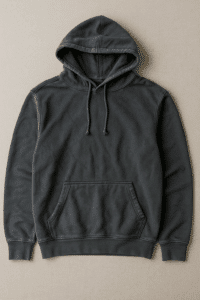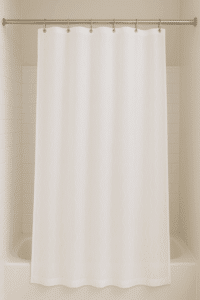How to Wash a Weighted Blanket the Right Way
Why proper care for weighted blankets matters
Weighted blankets have become nightly essentials for stress relief and better sleep, but cleaning them requires a careful touch. These blankets can weigh anywhere from 10 to 30 pounds, and that extra heft means they can strain a normal washer or dryer if not handled correctly. Proper care matters not just to avoid ruining an expensive blanket (or your appliances) – it’s also about keeping it fresh and hygienic. Even with a cover, a weighted blanket collects sweat, oils, and spills over time, so it needs washing just like any other bedding. We’re all doing plenty of laundry already (the average household tackles around 7 loads a week and spends about 4 hours on laundry chores), so learning how to wash a weighted blanket the right way will save you time and hassle in the long run.
Can you wash a weighted blanket at home? In many cases, yes – but it depends on the blanket’s size, filler, and care instructions. Washing a weighted blanket improperly can damage the filler or fabric, so always start by checking the care tag. Some weighted blankets are fully machine washable, some have a removable cover that you wash separately, and others might be spot clean only. In plain language: follow what the label says. If the tag says “dry clean only” or “spot clean only,” do not attempt a full wash at home (you’ll risk a lumpy blanket or worse). But if it’s machine-friendly, or if you’re wondering how to clean a weighted blanket that’s just a bit too big for your washer, read on – we’ve got you covered with neighbor-approved tips for both machine and hand washing.
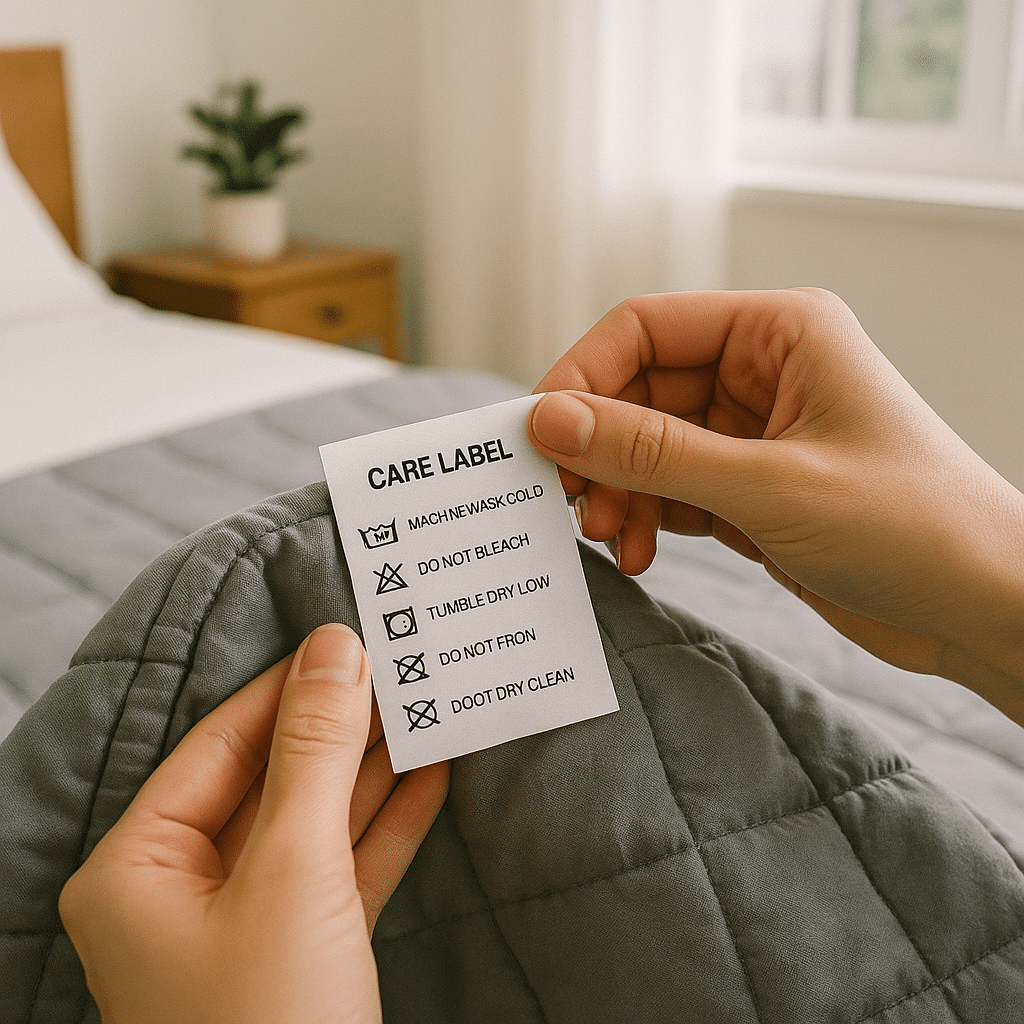
Machine vs hand washing: depends on weight and fill
A key question is whether to wash a weighted blanket in your washing machine or by hand. The answer hinges on the blanket’s weight and filling material. Here’s how to decide:
- Weight matters: Blankets under about 15–20 pounds can typically be washed in a large-capacity washing machine on a gentle cycle. Heavier blankets (or even a 15 lb blanket in a small home washer) can put strain on the machine. If your weighted blanket is over that threshold or barely fits in your washer, play it safe – head for a laundromat with oversize machines or use a professional service instead of risking your home appliance.
- Filler type: What’s inside your blanket is just as important. Most commercial weighted blankets use micro glass beads or plastic poly pellets as filler. Both are generally safe to wash, but glass beads can become abrasive or even crack if exposed to high heat (and wet glass makes a blanket very heavy), while plastic pellets can warp or melt in high heat. Always use cold or lukewarm water and avoid hot settings. If your blanket uses organic fillers like rice, corn, or beans, do not submerge it in water – those natural materials will absorb water, clump, or even mold. In that case, stick to spot cleaning and consider using a removable, washable cover to protect the blanket.
- Outer fabric: Check the outer material of your weighted blanket. Cotton, microfiber, and fleece shells can usually handle gentle machine washing (with cool water for cotton to prevent shrinkage). Delicate fabrics like silk or wool should not go in the washer – they may require hand washing or professional dry cleaning to avoid damage. When in doubt, always defer to the care tag or the manufacturer’s website for specific guidance on your blanket’s materials.
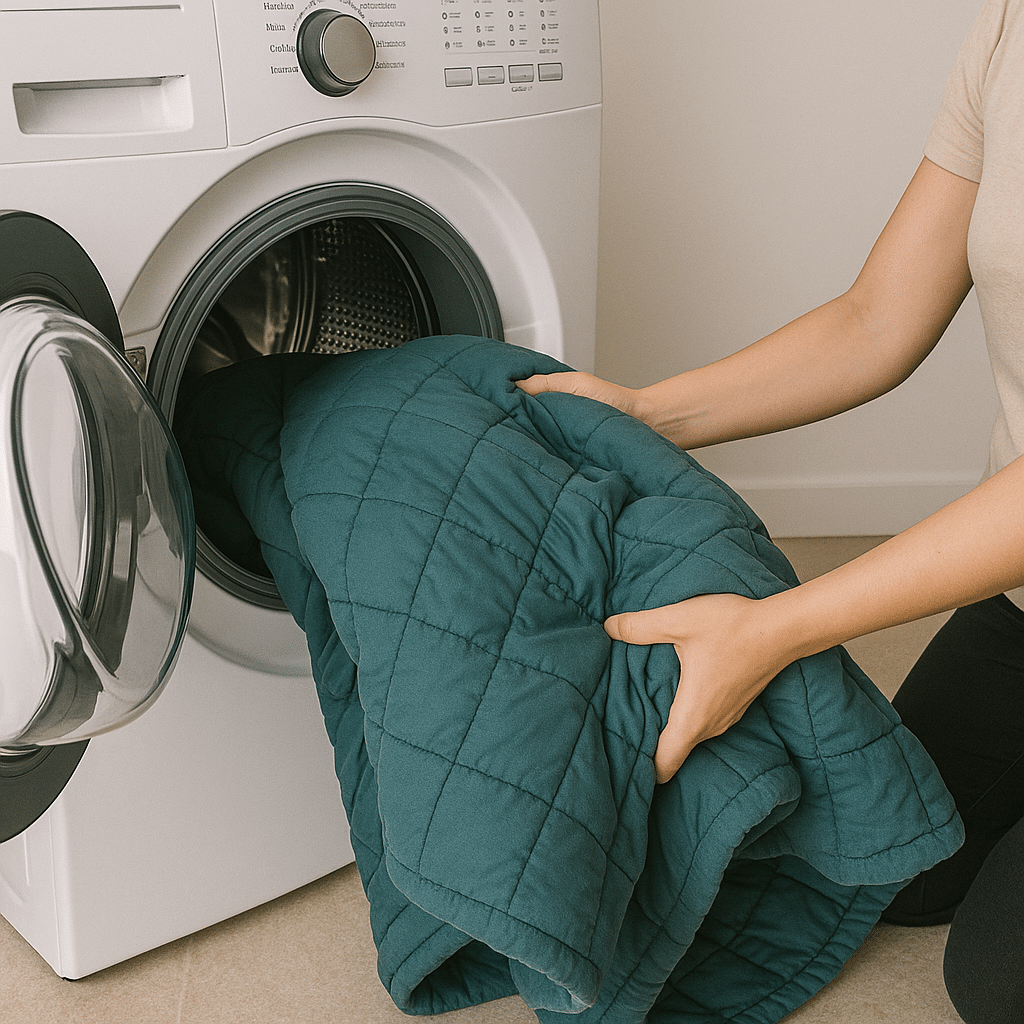
Machine washing a weighted blanket: If your blanket is machine-washable and within the weight your washer can handle, wash it by itself – don’t toss other clothes or linens in the same load. Use a mild detergent (fragrance-free, bleach-free) and select the gentle or delicate cycle (some washers even have a “bulky” or “blanket” cycle, which works well for heavy items by using more water and a slower spin). Wash in cold water; warm is okay for sturdy fabrics, but cold is safest for the filler and prevents any shrinkage or color fade. Avoid bleach and fabric softeners entirely – bleach can weaken fibers, and softeners can leave a residue that builds up, making the blanket feel scratchy over time. To protect your machine, set the spin to low or medium; the extra weight can cause wobbling, so a slower spin helps keep the washer balanced. It’s a good idea to pause mid-cycle and reposition the blanket if you hear the washer struggling or thumping, especially with top-loading machines. Finally, ensure the blanket has enough room to move around in the drum – if it’s wedged in tightly, it won’t get fully clean. In that case, take it to a facility with bigger machines (your local self-service laundry can be a big help for one of these hefty blankets).
Hand washing a weighted blanket: Many people ask how do I wash a weighted blanket by hand if I don’t have a suitable washer. Hand washing is an option for certain cases – for instance, if your blanket is slightly over the weight your machine can handle, or if it’s made of a delicate material that you don’t want to machine wash. Be aware, though: a soaked weighted blanket is extremely heavy and a bit unwieldy. It’s wise to get a helper to lift it, and don’t strain your back. Here’s how to clean a weighted blanket by hand:
Fill a bathtub (or large utility sink) with cool water and a small amount of mild laundry detergent. You don’t need a ton of soap – too much will be hard to rinse out. Submerge the blanket fully and gently press the water through it. Let it soak for about 15–30 minutes. You can swish it around occasionally, but avoid aggressive scrubbing, which could stretch or tear the fabric. After soaking, drain the tub and refill with clean water (or run the shower) to rinse. Press out suds and water gently; do not wring or twist the blanket, as that can damage the filling pockets and seams. You may need to rinse a couple of times to get all the soap out. Once it’s rinsed, it will be very heavy with water – fold or roll it up while still in the tub to squeeze out excess water before you attempt to lift it. Then move on to drying immediately. Note: Some cleaning experts actually discourage hand-washing very heavy blankets because of how cumbersome it is. If at any point it seems unmanageable, don’t hesitate to skip the DIY and get some help from a laundry professional.
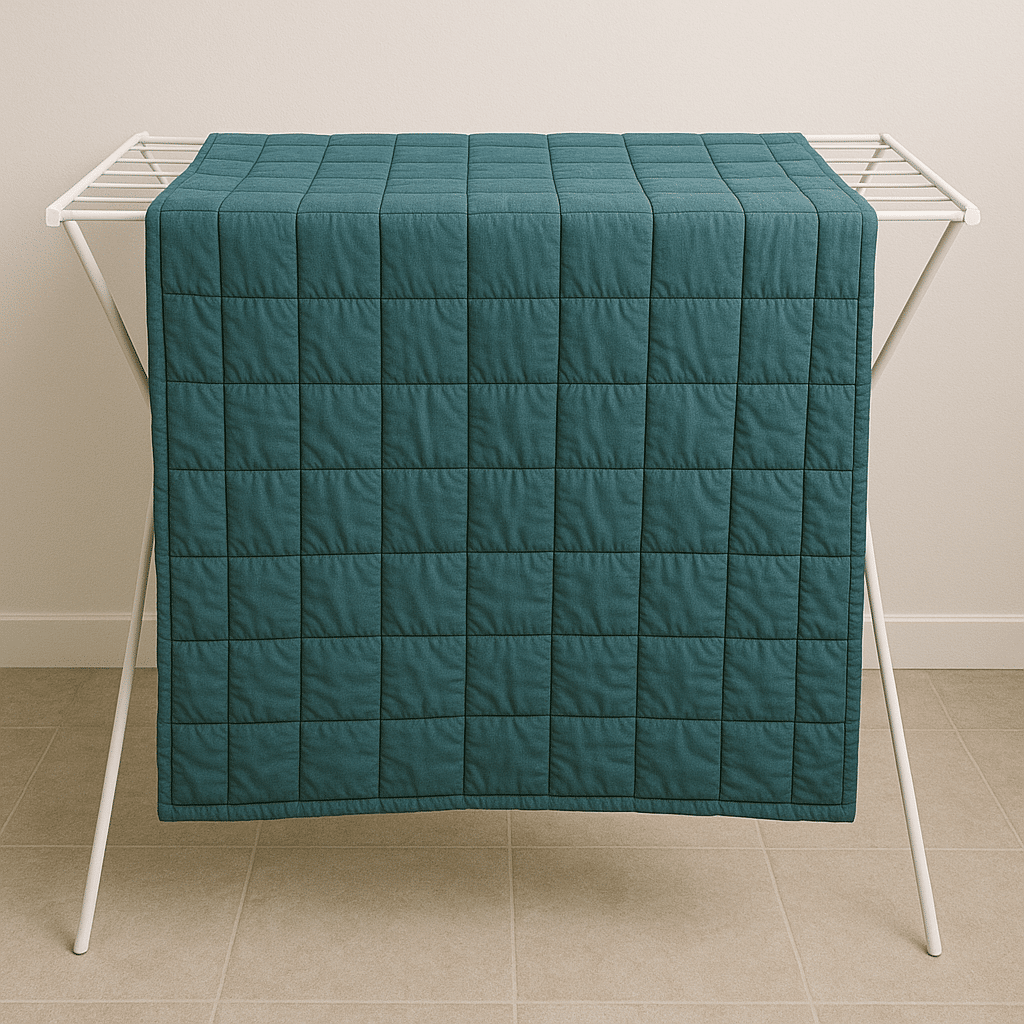
Drying your weighted blanket safely
Drying is a crucial part of washing a weighted blanket. Many blankets can’t handle high heat, so you’ll want to be cautious and patient here. First, check the care instructions for any notes on drying. Some weighted blankets are dryer-safe on low heat, while others specify air dry only. If machine drying is allowed, use the lowest heat setting (tumble dry low) and make sure your dryer is large enough for the blanket to tumble freely. It’s important that air can circulate around the blanket; if it’s bunched up in a small dryer, it won’t dry evenly. You might want to add a couple of dry towels or dryer balls to help distribute the load and absorb moisture. Every 20–30 minutes, pause the cycle to fluff and reposition the blanket so it dries uniformly. **If you hear your dryer struggling or the blanket balled up on one side, stop the cycle and spread the blanket out before continuing.**
Air drying is often the safest route for weighted blankets, especially those with glass beads or sensitive materials. To air dry, lay the blanket out as flat as possible on a drying rack or over a clean bannister or shower rod. (Make sure whatever you use can support the weight – a soaked weighted blanket can be 2–3 times heavier than when dry.) It’s best to dry it horizontally if you can, rather than hanging from one corner, to prevent the inner weights from sagging to one side. For example, you can drape the blanket evenly over several parallel bars of a laundry rack. This supports the weight and helps it keep its shape. Expect air drying to take a while – often 24 to 48 hours for a full drying, depending on thickness. Flip or rotate the blanket every few hours so all parts get exposure to air. If you’re drying outdoors, a breezy, sunny day can speed things up (sunlight also acts as a natural deodorizer). Just avoid leaving it out overnight or in damp weather. Whichever method you choose, ensure the blanket is completely dry before using or storing it. Any residual dampness inside could lead to mildew or a musty smell, especially because the fill is dense. Patience is key here: a properly dried weighted blanket will stay fresh and won’t develop that funky odor that comes from trapped moisture.
How often to wash a weighted blanket
Unlike your regular sheets or clothes, a weighted blanket doesn’t need constant washing – but it does need periodic refreshment to stay clean and cozy. How often you wash it depends on use and personal preference. If you use your weighted blanket every night (especially without a cover), a good rule of thumb is to wash it about once per month. Some experts say every three weeks or so for nightly use, which makes sense if it’s in direct contact with your skin regularly. On the other hand, if you only use it occasionally – say, for calming down on stressful days or extra-chilly Chicago nights – then washing it once every three to four months is plenty. A seasonal wash (one mid-season and another before you put it away for the warmer months) is a neighbor-approved strategy to keep it fresh.
Certain situations call for more frequent cleaning. If you have allergies or asthma and your weighted blanket collects dust, pet hair, or other allergens, you might want to wash it every month or two to keep irritants at bay. Likewise, if a pet often lounges on your blanket or if you’ve had a spill, it will need attention sooner. The key is to pay attention to signs – if the blanket starts to smell less than fresh, or you notice visible dirt or stains, go ahead and wash it. Remember that frequent full wash cycles can shorten the lifespan of any blanket (the agitation and spin are wear and tear), so it’s ideal to find a balance. Use a removable duvet cover on your weighted blanket if possible; you can wash the cover as often as your regular bedding (weekly or biweekly) and dramatically cut down how often the heavy blanket itself needs laundering.
Spot cleaning and odor control between washes
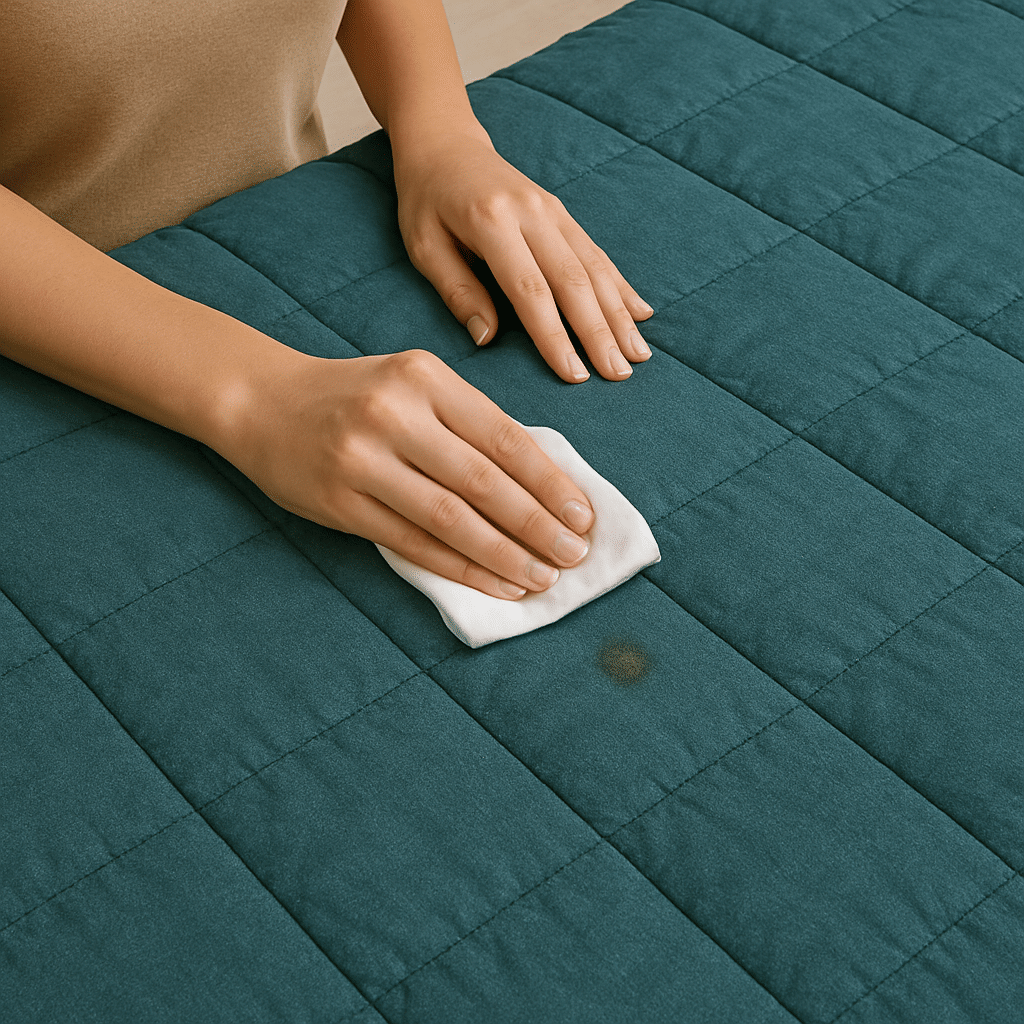
Day-to-day life happens – maybe you spilled a bit of coffee on the blanket, or your dog claimed it for a nap. For small stains or spills, spot cleaning is your first line of defense. Taking care of a spot quickly can prevent a permanent stain and means you won’t have to wash the entire heavy blanket each time. To spot clean, mix a few drops of mild detergent into cool water. Dip a clean cloth or sponge into the soapy water and gently blot the stained area (don’t oversaturate one spot, especially if the blanket has organic fill that shouldn’t get drenched). Avoid aggressive rubbing, which can push the stain deeper or damage the fabric’s nap – instead, use light circular motions with a soft cloth or even an old toothbrush on tough spots. Once the stain lifts, dip another cloth in plain water and blot the area to rinse out any soap. Press with a dry towel to absorb excess moisture and then let that area air dry completely.
Odor control is another common concern with heavy blankets, since they can be a bit harder to wash frequently. The good news is you can keep your weighted blanket smelling fresh with a couple of simple tricks. The easiest method is regular airing – on a dry day, hang the blanket over a clothesline or railing outdoors for a few hours. Fresh air and a little sunshine work wonders in eliminating musty odors (and UV rays can help kill odor-causing bacteria, too). For a deeper deodorizing between washes, sprinkle baking soda over the blanket surface and let it sit for an hour or longer. Baking soda naturally neutralizes odors. Afterward, shake the blanket out well or use the upholstery attachment on your vacuum to remove the powder. This leaves no scent at all, just freshness. One thing to be cautious about: avoid spraying commercial fabric refreshers or essential oils directly on the weighted blanket. While a lavender scent might sound nice for sleep, those liquids can leave stains or residue on the fabric. A safer way to add a pleasant aroma is to store the blanket (when it’s clean and fully dry) with a sachet of dried lavender or another herb in your closet. That imparts a light, calming scent without any risk of damage.
When to consider professional help
Washing a weighted blanket can be a workout – and sometimes it’s okay to call in reinforcements. If your blanket is too heavy or bulky for you to handle comfortably, or if you simply don’t have the time or equipment, consider letting a professional laundry service take care of it. For example, a blanket over 20 pounds might be best off in a commercial-grade washer and dryer. Rather than wrestling with it yourself, you can drop it off for wash & fold service or schedule a convenient laundry pickup. We’re laser-focused on saving you time – our team will launder your weighted blanket with the right techniques (and yes, we have high-capacity machines that can handle the job). Professional cleaners also inspect for any weak seams or other issues to ensure the blanket comes back to you in top shape.
Another reason to seek help is if the care label indicates “dry clean only” or if the blanket has a tricky material you’re not comfortable washing at home. Rather than risk it, you can trust a reputable cleaner. Some modern laundry services (like ours) even use advanced methods such as ozone sanitization for an extra-deep clean without harsh chemicals – a nice perk for something that’s used as closely as a blanket. Ultimately, the goal is to keep your favorite weighted blanket clean, fresh, and long-lasting. Whether you do it yourself or get a little neighborly help from a professional service, following these guidelines will ensure you can enjoy the calming comfort of your weighted blanket night after night, worry-free.

